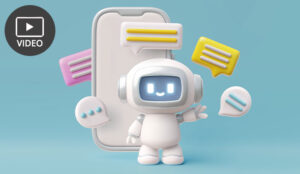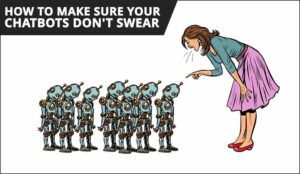Daniel Yin of RingCentral argues that customer service is changing due to the rise of artificial intelligence (AI).
According to a MyCustomer report, 80% of all UK businesses will have a chatbot solution in place by the end of 2020.
The rise of artificial intelligence and the accessibility of disruptive technology in the current marketplace means that any company can take their business to the next level with an AI chatbot.
Unfortunately, brands from most industries are still facing a host of challenges when it comes to getting the full value out of intelligent solutions.
Here, we’re going to cover everything you need to know about the market for modern chatbot tools, and how they can help you to transform customer service.
What Are Chatbots?
Chatbots are computer programs built on the concept of “artificial intelligence” and data analytics.
These tools automatically respond to messages sent through a website or application, either drawing information from a database or using AI algorithms to learn over time.
In the modern customer service environment, messaging a chatbot is intended to give consumers a similar experience to messaging a sales assistant. However, some of these applications are more advanced than others.
Currently, it’s often quite easy for customers to tell when they’re speaking to a chatbot instead of a human. However, this is often regarded as a good thing. 59% of customers say that they want AI chatbots to make it clear that they’re speaking to a bot.
Developments in the artificial intelligence market are leading to new and improved chatbot installations. For instance, some of the more advanced bots available through companies like RingCentral can use solutions like natural language processing to create a more “conversational” experience for end users.
The Current Market for the AI Chatbot
More customers than ever before are shopping and interacting with brands online.
However, they don’t want to do everything alone. 83% of consumers say that they want to access support at any time during their buyer journey. Additionally, more than half of all customers say that they expect their favourite brands to be able to answer questions at any time of the day or night.
A customer service chatbot is quickly becoming a must-have for businesses that want to adhere to the ever-evolving needs of their customers. In the era of artificial intelligence, the chatbot market is seeing extraordinary growth – particularly in the customer service space.
According to a report by Global Market Insights, the chatbot market will be worth $1.34 billion by 2024. What’s more, 42.52% of that market will be dedicated to customer service.
Chatbots have the power to deliver more immersive, personalised experiences at any time of the day or night – wherever your customers might be. With an AI chatbot, you can deliver custom support when your people need it most, eliminate unnecessary waiting time, and even take some extra stress off the shoulders of your contact centre agents.
A Brief Timeline of Chatbots
A chatbot is a computer program or artificial intelligence solution that interacts with users through audio or text. These tools can come in many different formats, depending on what you need to use them for.
Although chatbots seem like a relatively new concept, they’ve actually been around for a lot longer than you may think. The idea of a chatbot first came to life with a man called Alan Turing, a computer scientist from England who wrote a paper in 1950 called “Computer Machinery and Intelligence”.
Turing’s article outlined the basics of the “artificial intelligence” test, which was designed to determine whether computers could truly think. Since then, computer scientists have been inspired to create ever-more intelligent bots. Joseph Weizenbaum created “ELIZA” in 1966 – the app that set the foundation for the structure of chatbots today. ELIZA introduced the world to keyword-enabled responses and programmed algorithms.
In 1995, a language processing bot named A.L.I.C.E. emerged, followed by SmarterChild in 2001, the precursor to tools like Siri.
However, the last decade has been the most impactful for the AI chatbot world. We’ve seen the development of countless new virtual assistants like Amazon Alexa and Google Now. What’s more, there’s been a meteoric rise in the availability of natural language processing and understanding technologies.
Chatbots are so valuable today that experts predict they’ll be responsible for up to $8 billion in annual savings by the end of 2022.
Chatbots and the Business World
The business environment today is more competitive than it’s ever been, and your consumers demand more from you if you want them to stick around.
Winning the hearts and minds of today’s digital customers means providing them with a highly immersive and targeted user experience. Your people want you to remember their preferences, choices, and product offers. That’s why companies are increasingly showing “personalised” product offers on their eCommerce sites.
Chatbots allow businesses to learn about the needs of their clients and adjust their customer service strategies accordingly. According to studies by Invespcro, AI chatbots reduce customer support costs by as much as 30%.
When combined with other AI solutions and data analytics, chatbots allow you to create engaging advertising campaigns, robust contact centre solutions, and even advanced sales strategies.
The Benefits of Using Chatbots in Business
Chatbots are incredibly valuable for businesses, and their value only increases as time goes on.
First and foremost, an AI chatbot is available to support your company 24 hours a day, seven days a week. They don’t get tired as we do, and they don’t need breaks. They’re also a lot better at performing the repetitive and mundane tasks that humans hate doing because they never get tired of answering emails or responding to the same question endless times.
When it comes to customer service, a chatbot is invaluable. Soon, you may find that waiting on hold is a thing of the past because intelligent bots will be able to answer questions for your customers and send them to the right person at the most appropriate time. Around 40% of customers say that they don’t mind if a human or a chatbot answers their questions, as long as they get an answer fast, as HubSpot research shows.
Some contact centres are already implementing chatbots that allow customers to request a callback when an agent becomes available.
Chatbots also help companies to save a significant amount of money. They mean that you don’t have to pay excessive amounts for extra employees to cover repetitive tasks. They also ensure that the employees that you do have can focus on more crucial, creative tasks, rather than wasting their time on the mundane things they’d rather not be doing. This means that your business becomes more productive and more profit-driven.
5 Best Practices for Building a Customer Service Chatbot
According to PwC research, 31% of business executives believe that virtual assistants and chatbots will have a massive impact on their company. However, you need the right implementation plan in place if you want to make sure that the outcome of your investment is positive.
The key to making the most out of an AI chatbot is ensuring that you have the right mindset from day one. It’s not just about using chatbots because they’re novel and interesting. Your bots should be designed to respond to problems your employees and customers are having.
Remember, when implementing a customer service chatbot:
1. Don’t Rely on Bots for Everything
When you consider all the cost and time-saving benefits of chatbots, using these tools seems like a no-brainer. However, an AI chatbot still has its limitations. If you have a complex product that requires personal emotive assistance, then a chatbot isn’t always the right solution. Sometimes, people need a human experience. They need to know that you empathise with their plight.
However, if you need to do something simple, like give customers answers to simple FAQs on social media, then a chatbot can definitely help. It’s all about finding the right balance between human and robotic support.
2. Give Customers Control
Another thing to remember when you’re building your chatbot is that your customer needs to have all the control. Don’t tell them when they can speak to a person and when they have to use a bot. Let them have the choice to automatically request a call or move to a chat with a human being when they feel like they need further help.
Additionally, make sure that your clients know that they’re dealing with a chatbot from the start. Remember that customers don’t like feeling as though they’re being “tricked” into using AI technology.
3. Make Sure That Your Bot Is Connected
The most effective AI chatbot solutions are the ones that can tap into information about your business and customer base. That means that you can create a more effective bot if you can link it in with your CRM data, your collaboration platform, and other crucial parts of your data analytics strategy. The more information you give your bot, the more it will be able to deliver personalised moments to your target audience.
Connecting your bots to the right systems can also mean that your employees get benefits from them – not just your customers. For instance, team members can ask a chatbot to remind them about following up with a customer. Or they might request that the bot schedule a meeting with a colleague. 34% of business employees say that chatbots allow them to free up crucial time, according to PwC research.
4. Chatbots Should Be Easy to Talk To
Just because your customers want to know that they’re speaking to a bot doesn’t mean that your AI shouldn’t sound as human as possible. Consumers want their conversations with AI tools to feel natural and pleasant. With that in mind, it’s essential to make sure that your chat experiences aren’t clunky or robotic.
You shouldn’t be creating an “uncanny valley” experience with your bots. However, giving them a general personality and sense of humour might be a good strategy.
5. Optimise Over Time
Finally, remember that, like your business, your chatbot will need to grow and develop over time. The more you learn about your customers, and the more advanced chatbot technology becomes, the better your system can be. Pay attention to how people are using your bot and use what you learn to make your chatbot strategy more effective over time.
It may take a while before you create the ultimate AI chatbot experience. However, with plenty of monitoring and patience, you can ensure that you’re giving your customers the kind of service they want.
How Do Customers Feel About Chatbots?
The good news is that customers appear to have an overwhelmingly positive attitude towards chatbots. Around 80% of clients in an Uberall study said that they feel good about the conversations that they have with bots.
Additionally, Opus Research suggests that 31% of customers would like to see more businesses using chatbots as part of their customer service strategy.
There are many reasons why people are starting to embrace chatbots more readily today. However, the biggest driver of all seems to be the demand for more speed in customer service. A study by SurveyMonkey, Drift, Salesforce, and MyClever found that customers feel chatbots are up to 35% better at answering quick questions than other applications.
Today’s customers don’t have the time to wait around for agents to answer their most basic questions, and chatbots can help with this. However, it’s worth noting that it’s the “basic” questions that customers feel most comfortable trusting to AI.
When it comes to dealing with a complex and emotional issue, there are still many consumers who would rather speak to a human agent.

Daniel Yin
That’s why it’s so important for companies implementing a customer service chatbot to ensure that they’re still giving their audience a choice. The future isn’t about replacing human agents with bots. Instead, it’s about supporting agents, and delivering better service through the combination of chatbot tools and human beings.
Companies still need to use their contact centre solutions from companies like RingCentral effectively, combining chatbot solutions with easy escalation options for human interaction. Get the balance right, and you’ll benefit from happier, more engaged customers.
Author: RingCentral
Published On: 7th May 2019 - Last modified: 26th Feb 2025
Read more about - Expert Insights, Artificial Intelligence (AI), Customer Service, RingCentral










































